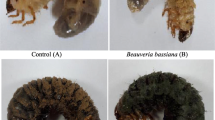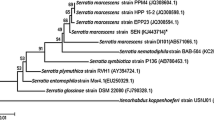Abstract
A 1% concentration ofBacillus thuringiensis wettable power (containing 16,000 IU/mg), applied at a rate of 48,000 IU/cm2, killed 95% of 4th-instar larvae of the carob moth,Ectomyelois ceratoniae (Zeller) (Lepidoptera: Pyralidae), after 66 h and 100% after 85 h of exposure in laboratory tests. The mortality caused by a 0.5% concentration (24,000 IU/cm2) was significantly lower and presumably inadequate for practical application against this pest.
Similar content being viewed by others
References
Abbott, W.S. (1925) A method of computing the effectiveness of an insecticide.J. econ. Ent. 18: 265–267.
Avidov, Z. and Harpaz, I. (1969) Plant Pests of Israel. Israel Universities Press, Jerusalem.
Gothilf, S. (1968) The biology of the carob mothEctomyelois ceratoniae (Zell.) in Israel. I. Mass culture on artificial diet.Israel J. Ent. 3(2): 109–115.
Harpaz, I. (1979) Regulatory measures adopted in Israel as regards the screening and field application of pesticides within the context of integrated control.Int. Pest Control 21(2): 28–30.
Izhar, Y., Wysoki, M. and Gur, L. (1979) The effectiveness ofBacillus thuringiensis Berliner onBoarmia (Ascotis) selenaria Schiff. (Lepidoptera, Geometridae) in laboratory tests and field trials.Phytoparasitica 7: 65–77.
Kellen, W.R., Hunter, D.K., Lindegren, J.E., Hoffmann, D.F. and Collier, S.S. (1977) Field evaluation ofBacillus thuringiensis for control of navel orangeworms on almonds.J. econ. Ent. 70: 332–334.
Pinnock, D.E. and Milstead, J.E. (1972) Evaluation ofBacillus thuringiensis for suppression of navel orangeworm infestation of almonds.J. econ. Ent. 65: 1747–1749.
Wysoki, M., Izhar, Y., Gurevitz, E., Swirski, E. and Greenberg, S. (1975) Control of the honeydew moth,Cryptoblabes gnidiella Mill. (Lepidoptera: Phycitidae), withBacillus thuringiensis Berliner in avocado plantations.Phytoparasitica 3: 103–111.
Author information
Authors and Affiliations
Rights and permissions
About this article
Cite this article
Harpaz, I., Wysoki, M. Susceptibility of the carob moth,Ectomyelois ceratoniae, toBacillus thuringiensis . Phytoparasitica 12, 189–191 (1984). https://doi.org/10.1007/BF02981172
Received:
Issue Date:
DOI: https://doi.org/10.1007/BF02981172




